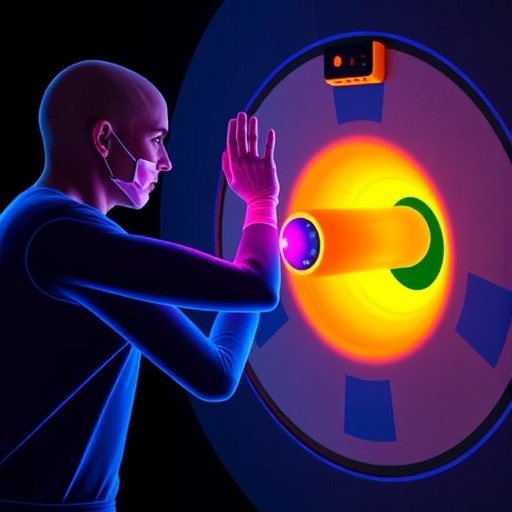In a groundbreaking study published in BMC Cancer, researchers have unveiled a promising new radiosensitizing agent, TOP-0618, a derivative of homocamptothecin, with significant potential to enhance radiotherapy outcomes in pancreatic cancer treatment. This discovery represents a vital stride in addressing one of the deadliest malignancies, notorious for its resistance to conventional therapies due to its complex tumor microenvironment and inherent heterogeneity.
Pancreatic cancer remains a formidable challenge in oncology, with survival rates stagnating despite advances in chemotherapy and radiotherapy. Its unique tumor microenvironment, characterized by dense stroma, hypoxia, and immune evasion mechanisms, creates formidable barriers to effective radiation damage. This compelling need for novel radiosensitizers has driven scientists to explore molecular agents that can potentiate the effects of radiation and overcome intrinsic cellular defenses.
TOP-0618, derived structurally from homocamptothecin—an analog of the well-established anticancer agent camptothecin—has been investigated rigorously for its ability to sensitize pancreatic cancer cells to ionizing radiation. The drug’s molecular mechanism is believed to involve inhibition of DNA topoisomerase I, resulting in stabilized DNA breaks that hamper repair processes, thereby enhancing radiation-induced cytotoxicity. However, what distinguishes TOP-0618 is its improved pharmacokinetic profile, offering enhanced cellular uptake and stability.
Further analysis revealed that TOP-0618 notably enhanced the radiosensitivity of both cell lines with sensitizer enhancement ratios (SER) of 1.14 and 1.65 for PANC-1 and MIAPaCa-2, respectively. This suggests a significant amplification of radiation-induced damage when combined with TOP-0618 treatment, improving the potential for tumor control with conventional radiation doses. Such enhancement is critical for clinical applications, where dose-limiting toxicity often restricts radiation levels.
Mechanistically, TOP-0618 was found to induce G2/M phase arrest in pancreatic cancer cells, a phase known for heightened radiation sensitivity. Cell cycle arrest at this checkpoint prevents tumor cells from repairing DNA before mitosis, thereby sensitizing them to radiation-induced apoptosis. Flow cytometry assays confirmed increased apoptotic populations in treated cells, indicating that TOP-0618 actively promotes programmed cell death pathways in synergy with radiation.
The transition from cell-based assays to in vivo experimentation further validated the therapeutic promise of TOP-0618. Using a pancreatic bi-flank xenograft tumor model, researchers demonstrated that the combined administration of TOP-0618 and irradiation significantly suppressed tumor progression compared to either modality alone. This comprehensive approach highlights the translatability of laboratory findings to complex biological systems.
Histopathological assessments of tumor specimens revealed marked increases in necrotic areas and apoptotic indices following combined therapy. Hematoxylin and eosin staining elucidated structural disruption within the tumor microenvironment, while TUNEL assays quantified DNA fragmentation associated with apoptosis. These findings confirm that TOP-0618 not only impedes tumor growth but also facilitates cellular dismantling through enhanced radiosensitization.
Crucially, the study addresses the critical issue of pancreatic cancer’s radioresistance by attacking multiple facets of tumor biology. By combining targeted molecular intervention with radiation, TOP-0618 offers a promising dual-pronged strategy that may circumvent resistance pathways and improve patient prognosis. This is especially significant given the limited success of radiosensitizers to date in this context.
As radiation doses escalate, normal tissue toxicity becomes a limiting factor, but the potentiation effect observed with TOP-0618 may allow lower doses to achieve similar, if not superior, therapeutic outcomes. This dose-modulating capacity is essential to reduce side effects while maximizing tumor control, making TOP-0618 an attractive candidate for clinical development.
The discovery also paves the way for future research into homologous compounds and combinational regimens, where TOP-0618 could be integrated with immunotherapy or chemotherapy, exploiting synergistic mechanisms that target pancreatic cancer’s multifaceted defenses. Understanding the molecular pathways influenced by TOP-0618 will be paramount for optimizing such treatments.
In conclusion, TOP-0618 emerges as a novel and effective radiosensitizing agent that holds promise for transforming the therapeutic landscape of pancreatic cancer. The detailed preclinical evaluation encompassing cellular, molecular, and in vivo analyses provides a robust foundation for subsequent clinical trials. Given the devastating prognosis of pancreatic cancer, advancements like this offer renewed hope for more effective, targeted, and personalized interventions.
As the medical community continues to grapple with pancreatic cancer’s complexity, the integration of novel radiosensitizers such as TOP-0618 into treatment protocols could mark a paradigm shift. Enhanced radiosensitivity not only improves local tumor control but may also synergize with emerging systemic therapies to extend survival and improve quality of life.
This research exemplifies the critical importance of translational science, bridging molecular discoveries with clinical applications to confront one of the most challenging oncologic diseases. The deployment of TOP-0618 in clinical settings, pending further validation, could redefine standards for radiotherapy and offer a new lifeline for patients diagnosed with pancreatic cancer.
Subject of Research: Pancreatic cancer radiosensitization using homocamptothecin derivative TOP-0618.
Article Title: Discovery of homocamptothecin derivative TOP-0618 as a radiosensitive agent for the treatment of pancreatic cancer
Article References:
Tang, Y., Huang, C., Chen, D. et al. Discovery of homocamptothecin derivative TOP-0618 as a radiosensitive agent for the treatment of pancreatic cancer. BMC Cancer 25, 936 (2025). https://doi.org/10.1186/s12885-025-14347-x
Image Credits: Scienmag.com
DOI: https://doi.org/10.1186/s12885-025-14347-x
Tags: BMC Cancer study resultsDNA topoisomerase I inhibitionenhancing radiotherapy outcomeshomocamptothecin derivativeimproved pharmacokinetic profileinnovative cancer therapiesmolecular agents for radiotherapynew radiosensitizing agentovercoming pancreatic cancer resistanceradiation-induced cytotoxicity enhancementTOP-0618 pancreatic cancer treatmenttumor microenvironment challenges





